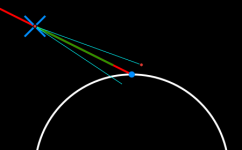A couple minor corrections to my above posts:
- "Any maneuver to avoid results in a miss"
should be
"Almost any maneuver to avoid results in a miss" - there is always a narrow range of deflection that merely delays the impact by requiring a correction in place of a some of the terminal velocity...
- "At 0.1C, Time Dilation is ignorable"
Well, that's actually Tref=Tmoving/√(1-(V/C)), which at 0.1C, gives us
Tref=Tmoving/√(1-0.1)
Tref=Tmoving/√(0.9)
Tref=Tmoving/0.9486832980505138
Tmoving=Tref*0.9486832980505138
So it's losing 6% of its speed by the end. Averaging out a square function is beyond my math (except iteratively), but I suspect it works out to be about a 2% loss of vector...
It's enough to make serious hit or miss.
And in Re Adam's Assertion that "every brachistochrone trajectory looks like a normal approach until the halfway point,"...
Wrong. Because every brachistrochrone trajectory is aiming for a future position. And because time crossing is a square function.
(Using subscripts to indicate temporal positions in the following)
A course from point A to B is actually a course from A₁ to B₂ not from A₁ to B₁.
Let's say the course is 1,000,000,000 m and acceleration is a mere 10 m/s²
Standard is find the halfway point, flip, and do twice. D=0.5AT² for each leg...
leg is 500,000,000, so 10,000 seconds, for a course length of 20,000 seconds.
For the straight burn course, however, 1000000=0.5AT² the total course is only 14142 seconds. A difference of 5858 seconds.
So given start at A₁, if it's aimed for B₂ it's an impact, but if it's aimed at B₃ it's brachistrochrone. If it's at Earth-orbital speed, 30 km/s, that's 175736 km of difference from B₂ to B₃... If I worked the calculator right, a hair shy of 1.4° difference in course aim.
There will be some variance due to other bodies gravities, as well... which makes an impact-possible possible-thrust cone different from a brachistrochrone course's, and once past the midpoint, that very quickly collapses.
Also, if the course and current burn look even close to an impact and current burn is insufficient for a turn-around to stop, you've got grounds to whack them. The 3I will commend you for it, even.

